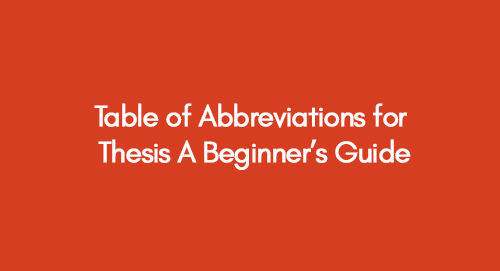
Footnote Referencing Styles: Academic Writing
July 27, 2023
Chemistry Dissertation Topics | List of Top 175 Topics in 2025
October 10, 2023You might wonder, "What on earth is a Table of Abbreviations?"
Well, think of it as a cheat sheet, a trusty map that guides your reader through the acronym-filled wilderness. It's like having a friend who's always there to explain those puzzling abbreviations that seem to pop up everywhere, from textbooks to technical manuals and even in everyday conversations.
Formatting the Table of Content for Dissertation
Review Comperhensive Guide for Layout the Dissertation
But why is this table so important, you ask?
So remember this, If your reader is engrossed in an article or a report, excited to absorb all that knowledge, when suddenly, they stumble upon an unfamiliar abbreviation. The reader's brain screeches to a halt, trying to make sense of the jumble of letters you use in your report. That's where the Table of Abbreviations swoops in like a superhero.
Get 3+ Free Custom Topics within 24 hours;
Define A Table of Abbreviations in Dissertation
Abbreviations play a vital role in condensing information and enhancing efficiency. From academic papers or dissertations to technical documents and beyond, abbreviations that significantly streamline complex content. However, with the vast array of abbreviations used in various fields, it's easy for readers to become overwhelmed or confused. This is where a well-structured and comprehensive "List of Abbreviations" comes to the rescue.
Sample of Abbreviation List
You do not have to worry about it; try to solve the issue for your readers. Here is a sample that can help you to build your own list of abbreviations thesis by giving you some ideas about what to include.
Abbreviations | Expansion |
e.g. | for example |
ANOVA | Analysis of Variance |
CSV | Comma Separated Value |
SEM | Standard Error of Means |
OR | Odd Ratio |
RR | Relative Risk |
QA | Quality Assurance |
SQL | Structure Query Language |
VV | Validation & Verification |
PhD | Doctor of Philosophy |
BSc | Bachelor of Science |
BA | Bachelor of Arts |
MBA | Master of Business Administration |
LLM | Master of Laws |
Please note that this is just an example, and the specific abbreviations and expansions you use will depend on the topic of your document. It is important to use abbreviations that are commonly used in your field and to define any abbreviations that may be unfamiliar to your readers.
Here are some tips for creating a table of abbreviations:
- List the abbreviations in alphabetical order.
- Use a consistent format for the abbreviations and their expansions.
- Include the page number where the abbreviation is first used.
- Use a table of contents to help your readers find the table of abbreviations.
Best Practices for Abbreviations List and Acronyms that You Must Know
When it comes to using abbreviations and acronyms in academic writing, there are a few important rules to keep in mind. By following these best practices, you can ensure clarity and consistency in your work. So, let's dive into some helpful tips:
- Introduce Acronyms
Acronyms are formed using the first letter of each word in a phrase. When you first mention an acronym, write out the full phrase and immediately follow it with the acronym in parentheses. After the initial introduction, you can continue using the acronym throughout the rest of your text.
For example: "All participants took part in the Drug Abuse Resistance Education (DARE) program. DARE targets young adults in high-risk neighbourhoods."
- Introduce Abbreviations
Similar to acronyms, abbreviations should be introduced with their full explanation the first time you use them. Afterwards, you can use the abbreviated version.
For example: "The research investigated commonly used acoustic-phonetic measures (ac. phone. measures). This ac. phon. measures were first researched by Strik et al. (2020)."
- Common Acronyms and Abbreviations
If you're using widely recognized acronyms or abbreviations like USA, PC, or NASA, you can use them from the beginning without providing their full explanation. However, if you're unsure about the familiarity of an acronym or abbreviation, it's always safer to write it out in full the first time.
- APA Style Considerations
If you are following APA Style guidelines, there are additional specific requirements for the use of abbreviations and acronyms in your dissertation. Be sure to consult the APA Style manual or guidelines to ensure compliance with their rules.
By adhering to these best practices for abbreviations and acronyms, you can maintain clarity and consistency throughout your academic writing. Remember to introduce and explain acronyms and abbreviations appropriately, allowing your readers to follow along with ease.
Always consult the specific style guide recommended by your academic institution or publisher to ensure accuracy and consistency in your writing.
Conclusion
The table of abbreviations serves as a powerful tool for simplifying the understanding of complex texts. Enhancing comprehension, promoting consistency and accuracy, saving time and effort, and improving accessibility, plays a crucial role in effective communication. Whether in academic papers, technical documents, or any form of written content, the presence of a well-constructed table of abbreviations empowers readers and enhances their overall reading experience. So, let us embrace the value of a table of abbreviations and make the complex more accessible, one abbreviation at a time.
Get an Immediate Response
Discuss your custom requirements with our writers
Free Online Plagiarism Checker For Students
We will email you the report within 24 hours.
Upload your file for free plagiarism


























